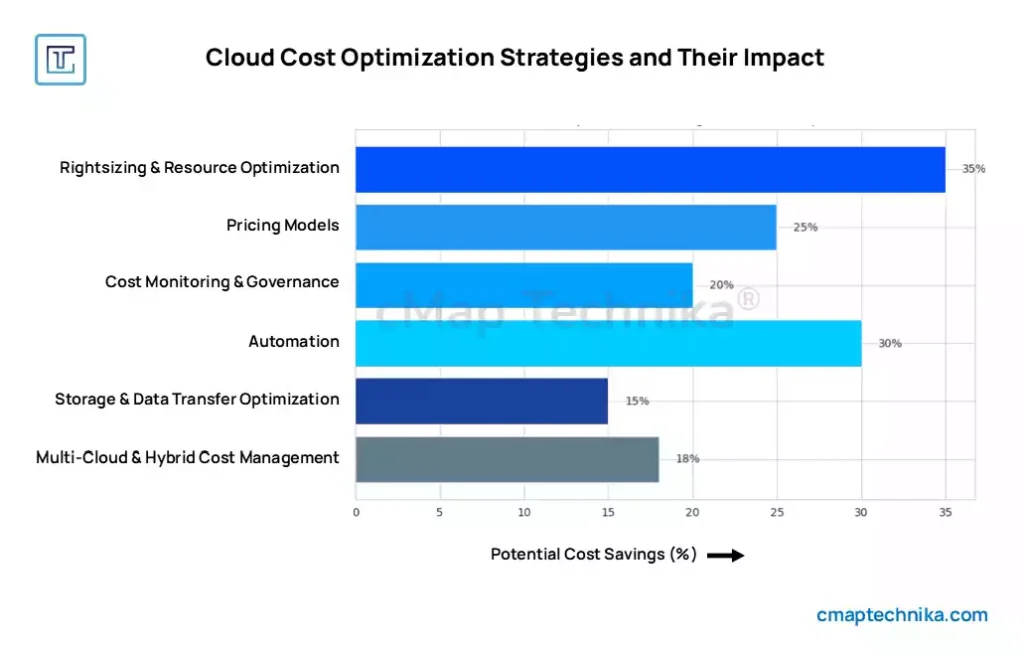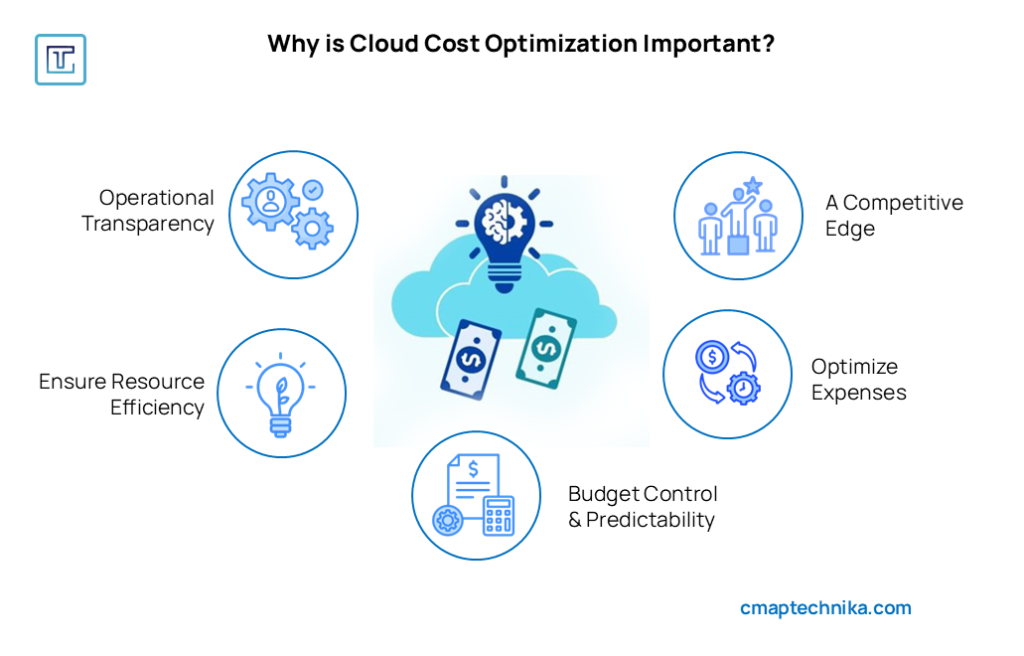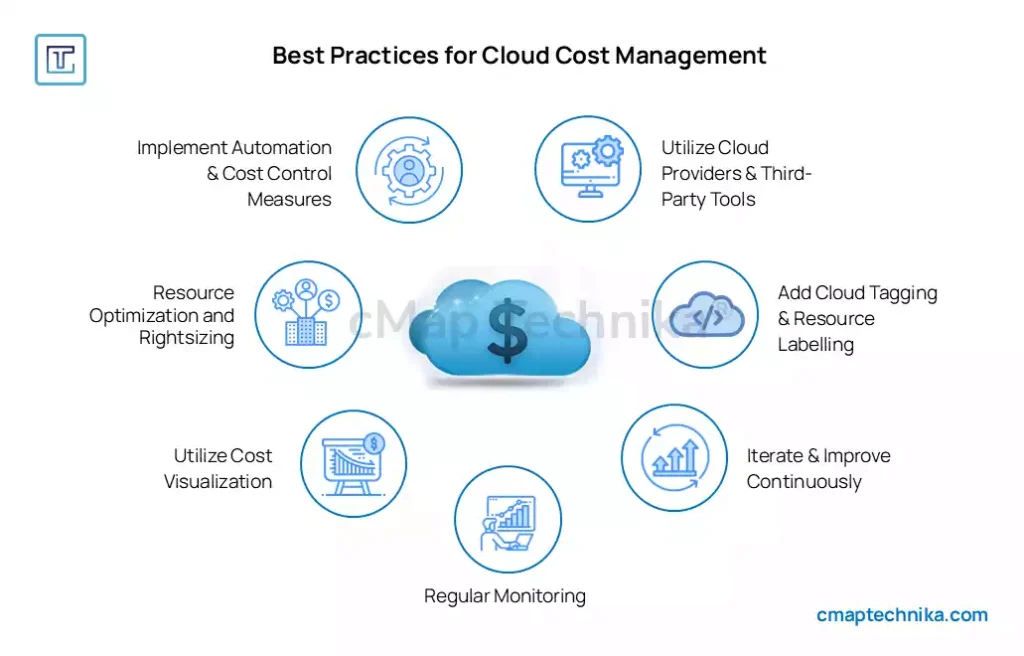Executive Summary

As organizations accelerate their shift to cloud environments, effective cost management has become a critical factor in maximizing return on investment. The flexible, pay-as-you-go pricing model of cloud computing offers numerous benefits, but without a well-defined strategy, businesses risk overspending, resource inefficiencies, and operational bottlenecks.
This guide provides actionable insights into key cloud cost optimization techniques, offering a structured approach to reducing expenses while maintaining performance, scalability, and security. By leveraging best practices such as resource allocation, rightsizing, automation, and intelligent pricing models, organizations can drive financial efficiency without compromising innovation. Industry insights, case studies, and expert recommendations will help enterprises implement governance frameworks and proactive monitoring strategies to ensure long-term cost sustainability.
With the right approach, businesses can transform cloud spending into a competitive advantage, ensuring they achieve maximum value while maintaining control over their cloud infrastructure.
Introduction

Cloud computing has revolutionized how businesses scale, innovate, and operate by offering unprecedented flexibility, scalability, and efficiency. However, its dynamic cost structure presents unique financial challenges. While the pay-as-you-go model allows businesses to pay only for what they use, poor cost visibility, unoptimized resource allocation, and the absence of governance can lead to escalating expenses, budget overruns, and underutilized cloud assets.
To mitigate these risks, organizations must adopt a structured cost optimization strategy that aligns with business objectives while ensuring performance, security, and operational continuity. Successful cloud cost management requires continuous monitoring, strategic resource provisioning, and automation-driven efficiency enhancements.
This business insight article explores the essential techniques for cost optimization in cloud computing, including rightsizing workloads, leveraging pricing models, implementing automation, and enforcing governance best practices. By adopting these strategies, enterprises can gain control over cloud expenses, drive sustainable cost savings, and maximize the value of their cloud investments.
1. Understanding Cloud Cost Structures
Cloud pricing models differ across providers, making it crucial to break down the key cost components for effective budgeting and optimization:
- Compute Costs – Expenses tied to virtual machines (VMs), containers, and serverless computing, often influenced by usage patterns, instance types, and auto-scaling configurations.
- Storage Costs – Charges for storing data, including object storage, block storage, snapshots, and backup solutions, which can vary based on access frequency and redundancy options.
- Networking Costs – Fees for data transfer, bandwidth consumption, and inter-region traffic, which can significantly impact costs depending on how data moves within and outside the cloud.
- Operational Costs – Expenses related to cloud management, security services, compliance tools, and third-party integrations that support governance and performance monitoring.
Understanding these cost drivers is essential for optimizing cloud spending, ensuring efficient resource allocation, and preventing unexpected overages.
2. Rightsizing and Resource Optimization
Optimizing cloud costs starts with rightsizing—ensuring cloud resources are aligned with actual workload demands to prevent overprovisioning and unnecessary expenses. By continuously refining resource allocation, organizations can achieve better performance at a lower cost.
Best Practices for Rightsizing and Optimization:
- Analyze Resource Utilization – Leverage cloud monitoring tools like AWS Cost Explorer, Azure Advisor, and Google Cloud Recommender to assess real-time usage, identify inefficiencies, and optimize consumption.
- Select the Right Instance Type – Choose the most efficient instance size and family based on workload requirements, balancing compute power, memory, and cost-effectiveness.
- Eliminate Underutilized Resources – Identify and decommission idle, redundant, or oversized instances that drive up costs without adding value.
- Implement Auto-Scaling – Dynamically adjust resource allocation based on demand spikes and workload fluctuations, ensuring optimal performance while avoiding unnecessary expenses.
By adopting a proactive approach to rightsizing, businesses can enhance cloud efficiency, prevent resource wastage, and drive sustainable cost savings.
3. Leveraging Cloud Pricing Models for Cost Efficiency
Cloud providers offer diverse pricing models that, when strategically utilized, can significantly reduce cloud expenses. Understanding these options helps businesses optimize their cloud investments while maintaining performance and flexibility.
Key Pricing Models:
- On-Demand Pricing – Pay-as-you-go model for compute and storage resources, ideal for unpredictable workloads that require flexibility.
- Reserved Instances (RIs) – Prepaid, discounted rates for a fixed-term commitment (1–3 years), best suited for stable, long-term workloads.
- Spot Instances – Deeply discounted, short-lived instances ideal for batch processing, testing, and non-critical workloads.
- Savings Plans – Flexible pricing structures that provide cost reductions in exchange for long-term usage commitments.
Best Practices for Cost Optimization:
- Balance On-Demand and Reserved Instances – Use on-demand for fluctuating needs while leveraging RIs for steady, predictable workloads.
- Utilize Spot Instances for Flexible Workloads – Maximize cost savings for jobs that can handle interruptions, such as testing and data processing.
- Optimize Licensing Costs – Regularly review software licensing agreements to eliminate redundant expenses and ensure compliance.
By strategically combining these pricing models, businesses can achieve the best balance between cost efficiency and operational agility.
4. Implementing Cost Monitoring and Governance
Effective cost monitoring and governance are essential to controlling cloud expenses, preventing waste, and ensuring financial accountability. Without proper oversight, cloud spending can quickly escalate, leading to inefficiencies and budget overruns.
Key Strategies for Cost Control:
- Establish Cloud Budgets and Alerts – Set up budget thresholds and real-time alerts using tools like AWS Budgets, Azure Cost Management, and Google Cloud Billing to proactively manage costs.
- Centralized Cost Governance – Implement a FinOps (Financial Operations) framework to align IT, finance, and business teams, ensuring transparency and accountability in cloud spending.
- Tagging and Cost Allocation – Use consistent tagging strategies to track expenses by project, department, or workload, improving visibility and accountability.
- Regular Cost Audits – Conduct routine cost audits to identify inefficiencies, eliminate underutilized resources, and optimize spending.
By integrating cost governance into cloud management strategies, organizations can enhance financial visibility, improve resource efficiency, and maximize ROI on cloud investments.
5. Automating Cost Optimization

Leveraging automation for cost management enables organizations to optimize cloud expenses in real time while minimizing manual intervention. By automating resource allocation, scaling, and policy enforcement, businesses can significantly reduce waste and improve efficiency.
Key Automation Techniques for Cost Savings:
- Automated Instance Scheduling – Schedule start/stop times for non-production environments, such as development and testing, to eliminate unnecessary costs during off-hours.
- Auto-Scaling Policies – Configure dynamic auto-scaling rules that automatically adjust compute resources based on real-time traffic and workload demands, preventing overprovisioning.
- Serverless Computing – Adopt serverless architectures (e.g., AWS Lambda, Azure Functions, Google Cloud Functions) to pay only for actual execution time, reducing idle resource costs.
- Policy-Based Cost Management – Enforce automated cost-saving policies through scripts that detect and eliminate unused storage, restrict unnecessary instance creation, and optimize licensing usage.
By integrating automation into cloud cost management, organizations can maintain optimal performance while ensuring financial efficiency, scalability, and long-term sustainability.
6. Optimizing Storage and Data Transfer Costs
Uncontrolled storage and data transfer expenses can significantly inflate cloud costs. To prevent unnecessary spending, businesses must implement strategic storage management and efficient data transfer practices.
Best Practices for Cost-Effective Storage and Data Transfer:
- Choose the Right Storage Tier – Optimize costs by selecting tiered storage solutions like AWS S3 Intelligent-Tiering, Azure Blob Storage tiers, or Google Cloud Coldline for infrequent data access.
- Implement Data Lifecycle Policies – Automate data retention and archival policies to transition rarely used data to lower-cost storage options, ensuring compliance without excessive storage expenses.
- Reduce Data Transfer Costs – Minimize unnecessary inter-region data movement and optimize bandwidth usage by leveraging Content Delivery Networks (CDNs) like Amazon CloudFront or Azure CDN for faster and cost-efficient content distribution.
By strategically managing storage and data transfer, organizations can significantly lower costs while maintaining performance, security, and compliance.
7. Managing Multi-Cloud and Hybrid Cloud Costs
Adopting a multi-cloud or hybrid cloud strategy offers flexibility and resilience but also introduces cost management complexities. Without a unified approach, businesses risk inefficiencies, hidden expenses, and budget overruns.
Key Strategies for Cost Optimization:
- Consolidate Billing Across Providers – Leverage cost management platforms like CloudHealth, Apptio, or AWS Cost Anomaly Detection to centralize expense tracking and identify cost anomalies across multiple cloud environments.
- Optimize Cross-Cloud Networking Costs – Minimize inter-cloud and inter-region data transfer fees by strategically routing traffic, optimizing workloads, and leveraging direct peering solutions to reduce latency and cost.
- Standardize Cost Governance Across Clouds – Implement cloud-agnostic policies that provide consistent cost visibility, budget enforcement, and resource allocation strategies across AWS, Azure, Google Cloud, and private clouds.
A well-defined multi-cloud cost management strategy ensures financial efficiency while maximizing the advantages of a diverse cloud infrastructure.
8. Future Trends in Cloud Cost Optimization
As cloud environments grow more complex, AI, automation, and FinOps frameworks are reshaping cost management strategies. Organizations must stay ahead of emerging innovations to enhance efficiency, predict costs, and drive financial accountability in cloud spending.
Key Emerging Trends:
- AI-Powered Cost Analytics – Machine learning models analyze real-time spending patterns, detect anomalies, and provide predictive budgeting insights to prevent cost overruns.
- Automated Workload Optimization – Intelligent workload placement optimizes compute and storage resources based on cost, latency, and compliance requirements, reducing waste and improving efficiency.
- Increased FinOps Adoption – More enterprises are integrating FinOps principles to foster collaboration between finance, IT, and operations, ensuring cloud investments align with business objectives.
With AI-driven automation and a data-driven FinOps approach, businesses can unlock sustainable cost efficiency and maximize the value of their cloud investments.
Conclusion
Effective cloud cost optimization is not a one-time effort but an ongoing strategic initiative that demands continuous monitoring, refinement, and innovation. Organizations that proactively manage their cloud expenditures through real-time monitoring, strategic resource allocation, automation, and governance frameworks can significantly reduce waste and enhance financial efficiency.
A structured approach to cost management ensures that businesses can scale their cloud infrastructure dynamically while maintaining security, compliance, and high performance. By leveraging automation, predictive analytics, and cloud-native cost control mechanisms, enterprises can prevent budget overruns and allocate resources more effectively to drive innovation.
Ultimately, cloud cost optimization is about balancing operational efficiency with business agility. Organizations that embed cost-conscious practices into their cloud strategy will not only minimize unnecessary expenditures but also unlock long-term savings, improve return on investment, and create a sustainable, future-ready cloud ecosystem. By following the best practices outlined in this guide, businesses can transform cloud spending into a strategic advantage, ensuring they derive maximum value from their cloud investments.






